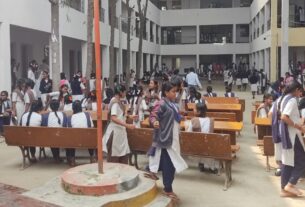Inclusive environment for the LGBTQIA+ community is still something that schools need to work on, say students
Schools in the city are yet to raise awareness and bring inclusivity for the LGBTQIA+ community, despite the National Education Policy (NEP) 2020 focussing on providing transgender individuals with equitable and inclusive education.
Rishi (name changed), a class 10 student who identifies as transgender said, “My school does not support this and I have never heard a proper discussion about gender inclusivity in my school. The environment in my school is heteronormative and gendered. Moreover, teachers here are also not supportive of my identity and refuse to accept it.”
The National Human Rights Commission report published in 2022 states that 64 percent of transgender adolescents felt unsafe at school due to sexual orientation and 31 percent said the school made no effort to respond to the harassment and violence.
Rishi also said, “As a transgender person, I never found any counsel or help in school regarding gender dysphoria and since there is no such awareness and acceptance among the teachers and staff, students feel no obligation to be accepting towards it. Other than a few whom I have communicated with, everyone else has an almost innate inclination to be homophobic, transphobic, and non-inclusive.”
NEP 2020 envisages gender-inclusive holistic education by including transgenders in Socio-economically Disadvantaged Groups (SEDGs) and making provisions for equitable quality education, and support for community-based interventions.
Psychiatrist Vani Prabha said that students in schools who go through gender dysphoria need someone in their school to openly talk about it rather than taking professional help that draws much attention. “I come across 10 to 11 cases of gender dysphoria in six months, children seeking help in this are generally in their teenage. They usually start questioning their gender identity at that age often but they are not sure about whom to talk to,” she said.
TheTransgender Persons (Protection of Rights) Act 2019 states that educational institutions must provide transgender students with inclusive education and access to adequate amenities. However, the 2022 report by the National Human Rights Commission shows, harassment at the school level, harassment by teachers, and verbal abuse are faced by transgender students in India.
Dison, a teacher at Christ School in Kengeri said, “There are no separate awareness programs or seminars held at school for the awareness of the LGBTQIA+ community but we do have a counsellor in case a student needs guidance regarding gender dysphoria or any indifference they face in school due to their gender identity.”
Naveen, a teacher at National Public School, “There is no means by which the school raises awareness about the community.” He also said that they do not educate students on the topic of the LGBTQIA+ community or gender dysphoria and have no communication with any students who might need help around the subject as the teachers are not very aware of the community.
Similarly, Devika, a teacher at Carmel School said, “We do hold numerous awareness programs and seminars about social issues but there is no awareness about the LGBTQIA+ community. Even the teachers are hesitant to talk on this topic so talking to students about this is far from discussion.”
Vani Prabha said, “I do feel glad when they reach me for professional help, this shows that the society as a whole is becoming aware of the issue and are ready to discuss it. But they approach me after a long battle of anxiety and restlessness around their gender identity which they are afraid to talk to their parents about.”
She further said, “If schools raised more awareness and a friendly environment then it would not be difficult for children to come out and talk about it. And they could talk to their school counselor instead of opting for professional help.”
Anushka, a class 12 student said, “My school is inclusive towards the LGBTQIA+ community. Teachers discuss it with students and programs are held to normalize it. This has changed the way, they look at queer people.” She also said, “There was lots of bullying and jokes around it before, but since the school has made it normal to discuss it with a counselor and raised awareness that has changed into inclusivity.”



